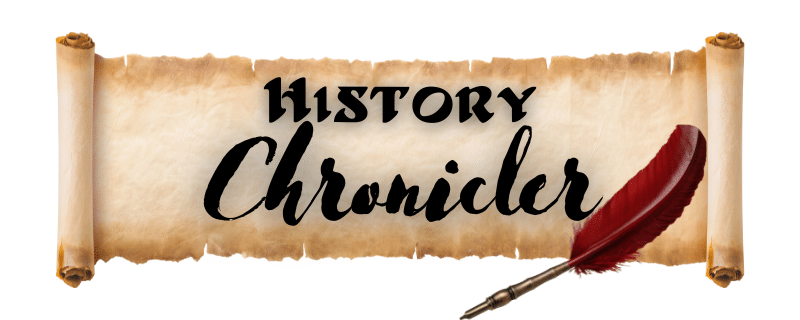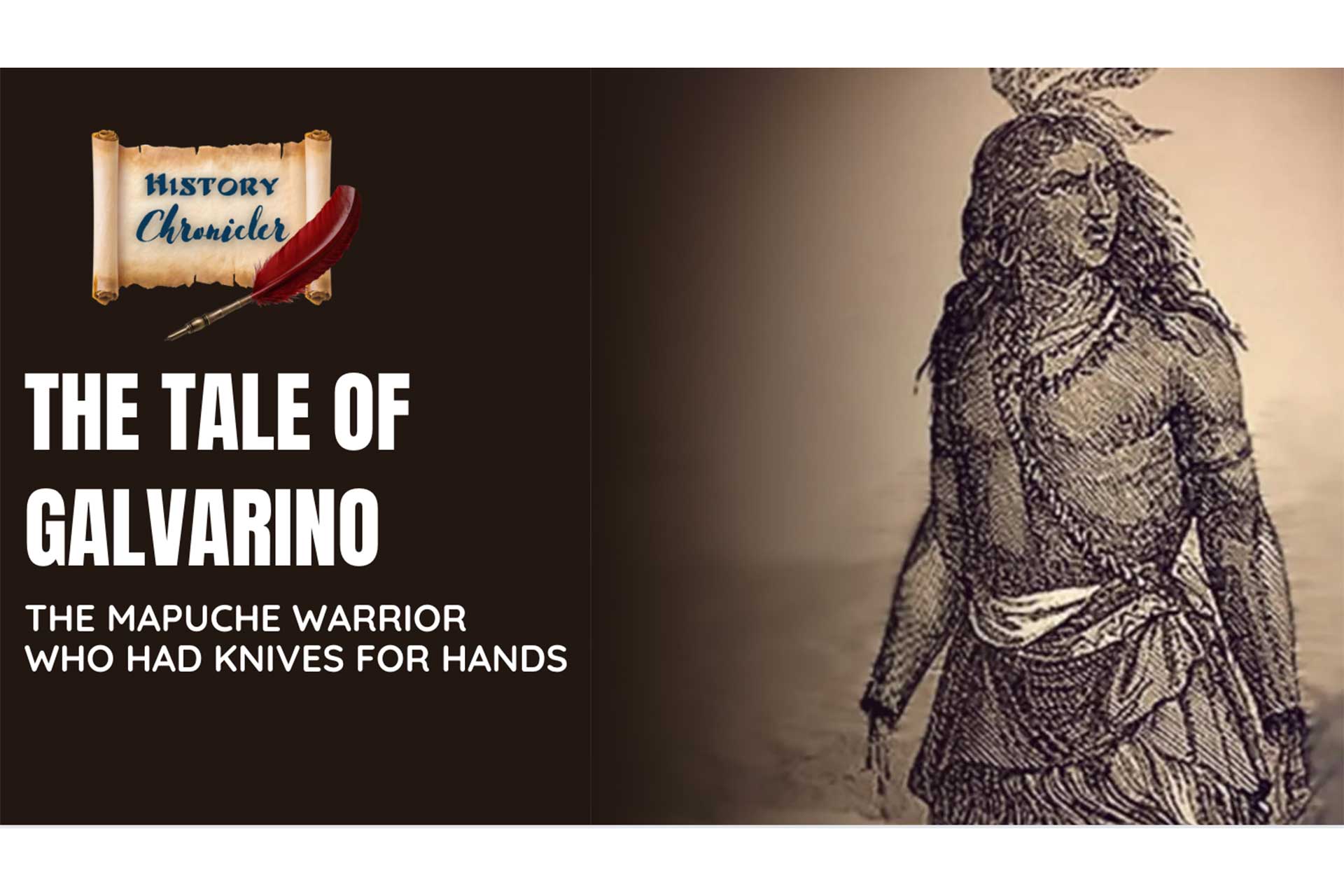Video Series: The Tale of Galvarino – The Mapuche Warrior Who Had Knives For Hands
In the 16th century, during the Arauco War, Galvarino, a warrior of the Mapuche people, becomes a symbol of defiance against Spanish conquerors after suffering brutal mutilation. Transforming personal tragedy into a rallying cry for resistance his story encapsulates the enduring spirit of the Mapuche in their fight against oppression and their quest to preserve their cultural identity and lands.
Video Transcription:
Video Series: The Tale of Galvarino – The Mapuche Warrior Who Had Knives For Hands
In the 16th century, the verdant landscapes of what is now Chile became the battleground for the Arauco War, a fierce conflict between the indigenous Mapuche people and Spanish conquistadors. Among the warriors of this era, Galvarino stood out as a symbol of resilience and defiance.
Galvarino was a warrior of the Mapuche, a people known for their formidable combat skills and deep connection to the land. Raised in a society organized around family clusters called ‘Lofs’ and led by chiefs known as ‘Lonkos’, Galvarino would have been trained in warfare from a young age.
The Mapuche, or ‘people of the land,’ have a rich history and culture, deeply rooted in their relationship with the environment. Their beliefs were centered around a struggle between good and evil, overseen by a supreme deity, Ngenechen, and guided by shamans called ‘Machi.
Prior to facing the Spanish, the Mapuche successfully resisted invasions by the Incas, showcasing their military prowess. Their initial encounters with the Spanish were peaceful, but tensions escalated as the Spanish pushed deeper into Mapuche territories, seeking gold and other resources.
In a strategic response to the impending Spanish invasion led by Governor García Hurtado de Mendoza, the Mapuche organized their defenses across several key locations. Despite their efforts, one of these defensive battles, The Battle of Lagunillas, led to Galvarino’s capture and the brutal amputation of his hands—a punishment meant to break the spirit of the Mapuche warriors as well as sidelining Galvarino from further fighting.
Undeterred by his mutilation, he converted his personal tragedy into a powerful symbol of resistance. Attaching knives to his amputated arms, he returned to his people not only to fight again but to inspire them with his unyielding spirit.Galvarino’s return to battle was not just a fight for survival but a statement against oppression. His leadership in subsequent battles, particularly his role alongside the Mapuche chief Caupolicán, underscored his importance as a symbol of resistance and the fierce determination of his people.
The Battle of Millarapue was a pivotal encounter between the Mapuche forces and the Spanish invaders led by Governor García Hurtado de Mendoza. The Mapuche, under the leadership of their Toqui Caupolicán, had gathered a force of around 20,000 warriors. On the other hand, the Spanish force, commanded by Mendoza, consisted of approximately 500 soldiers, supported by a contingent of indigenous allies.
The battle commenced with both sides engaging in fierce combat. The Mapuche, despite being outnumbered, fought valiantly and inflicted significant casualties on the Spanish forces. Leading his squadron with the knives attached to his arms, demonstrated extraordinary courage and determination. He managed to kill Mendoza’s second in command, a notable event that boosted the morale of the Mapuche forces. However, the Spanish, with their superior weaponry and tactics, ultimately gained the upper hand.
The Mapuche forces suffered heavy casualties during the battle. It is estimated that around 3,000 Mapuche warriors were killed, while the Spanish lost around 40 men, with many more wounded. Despite the numerical superiority of the Mapuche, the technological advantage of the Spanish, coupled with their well-organized tactics, proved decisive in the outcome of the battle.
After hours of intense fighting, the Mapuche forces began to retreat. Galvarino, who had fought with unwavering determination and had inspired his fellow warriors with his bravery, was captured by the Spanish during the retreat. His capture marked a turning point in the battle and served as a blow to the morale of the Mapuche forces.
Following his capture, he was brought before Mendoza. Despite the brutal punishment he had already endured and the loss suffered in the battle, he remained defiant. Some sources say Galvarino was “fed to the dogs”, however, most sources concur that he was sentenced to execution by hanging. His execution was carried out in front of the remaining Mapuche prisoners as a warning to those who continued to resist Spanish rule.
His death marked the end of a chapter in the Mapuche resistance against Spanish colonization. His bravery, both in the face of brutal punishment and on the battlefield, made him a symbol of resistance for the Mapuche people and an inspiration for future generations.
The Battle of Millarapue did not mark the end of the Mapuche resistance against the Spanish colonizers. Despite the loss of one of their iconic leaders, including Galvarino, and the heavy casualties suffered during the battle, the Mapuche people continued to demonstrate resilience and determination in their struggle against the Spanish invasion. The Mapuche forces organized several other military campaigns and rebellions in the subsequent years.
Although they faced formidable challenges, including superior Spanish weaponry and tactics, the Mapuche were able to sustain a prolonged resistance, which lasted for several centuries. This unrelenting struggle against colonization made the Mapuche one of the few indigenous groups in the Americas to successfully resist domination by a European colonial power for an extended period of time.
Image Attribution:
• DRAWING REPRESENTING A MAPUCHE WARRIOR ON HORSEBACK – OCTOBER 1911 REVISTA SELECTA, PUBLIC DOMAIN, VIA WIKIMEDIA COMMONS
• MAPUCHE VILLAGE INTERNET ARCHIVE BOOK IMAGES, PUBLIC DOMAIN, VIA WIKIMEDIA COMMONS • MAPUCHE MEDICINE WOOD, JOHN GEORGE, 1827-1889, PUBLIC DOMAIN, VIA WIKIMEDIA COMMONS
• INCA ARMY MARCHING Miguel Vera León from Santiago, Chile, CC BY 2.0, via Wikimedia Commons
• THE SPANISH TRADING WITH THE MAPUCHE IN CHILE RICHARDSON & COX, PUBLIC DOMAIN, VIA WIKIMEDIA COMMONS
• García Hurtado de Mendoza Ovalle, Alonso de, 1601-1651, Public domain, via Wikimedia Commons
• Arauco War Ilustración de Gerónimo de Bibar en su Crónica y relación copiosa y verdadera de los reynos de Chile., Public domain, via Wikimedia Commons
• Galvarino La Araucana : poema / de D. Alonso de Ercilla y Zúñiga. Ed. ilustrada. Madrid : Impr. y Libr. de J. Gaspar Editor, 168 p., Public domain, via Wikimedia Commons
• Galvarino By AnderTRON
• La Araucana : poema / de D. Alonso de Ercilla y Zúñiga. Ed. ilustrada. Madrid : Impr. y Libr. de J. Gaspar Editor., Public domain, via Wikimedia Commons
• Ovalle, Alfonso d’ (1601-1651 ). Cartographe, Public domain, via Wikimedia Commons
• Sociedad “Impr. y Litografía Universo”, Public domain, via Wikimedia Commons
• B.diaz.c, CC BY-SA 3.0, via Wikimedia Commons
• Amillò G, Public domain, via Wikimedia Commons


![[Video] Voices of Revolution: Five Women Who Shaped the French Revolution](https://historychronicler.com/wp-content/uploads/2025/05/Screenshot-2025-05-16-at-2.32.58 PM.jpg)
![[Video] Women of the American Revolution Part 2](https://historychronicler.com/wp-content/uploads/2025/04/Screenshot-2025-04-12-at-2.54.41 PM.jpg)
![[Video] Remarkable Women Who Defied Medieval Norms](https://historychronicler.com/wp-content/uploads/2025/03/Screenshot-2025-03-29-at-4.30.24 PM.png)
![[Video] Olga of Kiev: From Vengeance to Veneration](https://historychronicler.com/wp-content/uploads/2025/04/Screenshot-2025-04-15-at-5.52.05 PM-768x512.jpg)
![[Video] Godfrey de Bouillon: First King of Jerusalem](https://historychronicler.com/wp-content/uploads/2025/06/Screenshot-2025-06-13-at-3.14.50 PM.jpg)
![[Video] Women of the American Revolution](https://historychronicler.com/wp-content/uploads/2025/03/Screenshot-2025-03-29-at-3.53.33 PM.png)